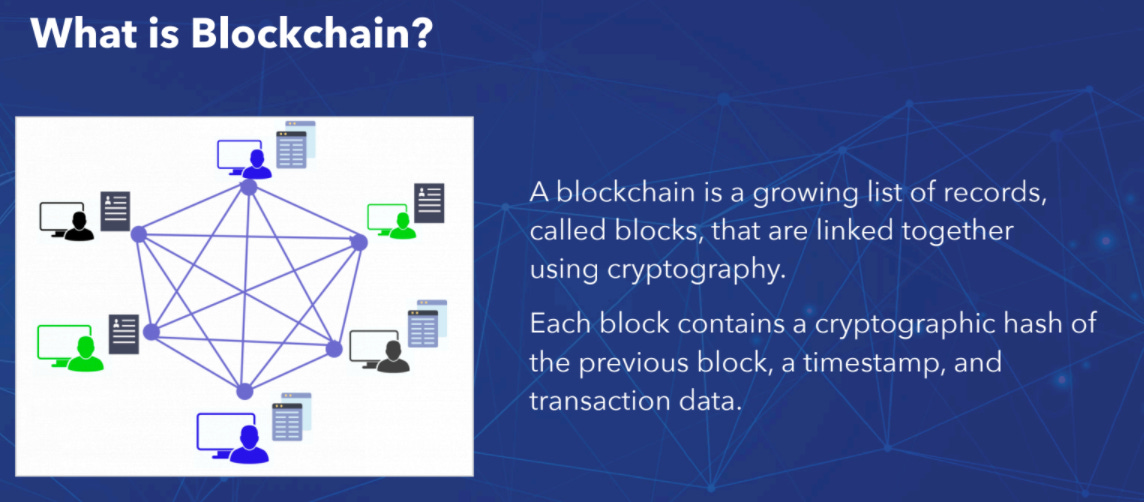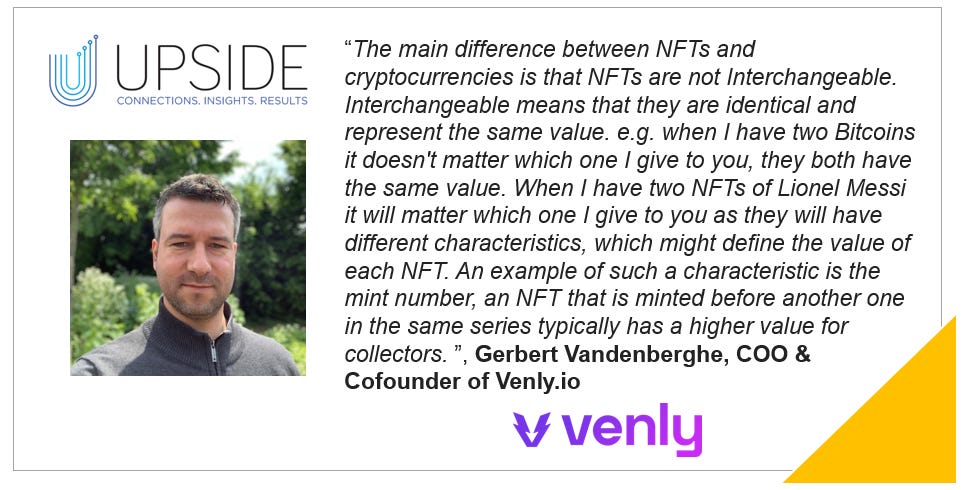🔗 🔥 Upside Analysis: NFTs Vs Crypto Vs Digital Currency, How Are They Different?
For the past 6 months we have been talking to lots of clubs regarding NFTs, what it is and how it can benefit them. But one thing is becoming more clear every day. Many clubs do not understand the difference between crypto and NFTs. And the clubs are not alone. The media seems to be confusing cryptocurrencies with NFTs. In this analysis we will go through the main differences between NFTs, cryptocurrencies and digital currencies.
Lots of confusion in the media about the difference between NFTs Vs cryptocurrency
Here is a typical example illustrating how many media do not understand the difference between NFTs and cryptocurrency. Last July, Arsenal FC announced a partnership with socios.com as shown in the picture below. The headline from the article was “Arsenal joins the NFT league with new fan token”. The writer explained the partnership as follow:
“Arsenal Football Club is next to enter the NFT scene, partnering with sports and entertainment industry blockchain provider, Chiliz, to launch the club’s $AFC Fan Token on the latter’s Socios.com mobile app. Socios.com will become a digital meeting place for Arsenal’s international fanbase, with the partnership reflecting the club’s drive to create a more engaging fan experience for its global following”.
The problem there is that socios.com is not an NFT company but a cryptocurrency. Basically in the same sentence the writer managed to refer socios.com and Chiliz while saying that Arsenal FC was entering the NFT market. This is an inaccurate statement and we believe that many media, as well as clubs, still do not understand the nuance between NFTs and cryptocurrency.
Source: Marketing-Interactive.com, Arsenal FC, socios.com, July 2021.
But before we get into the differences between NFTs, cryptocurrencies, digital currencies, let’s start with some basics.
What is blockchain?
As shown in the graph below, Blockchain can be defined as a growing list of records called blocks, that are linked together using cryptography. Each block contains a cryptographic hash of the previous block, a timestamp and transaction data.
Source: STARGraph
Currently blockchain’s main application has been around cryptovalues such as Bitcoins. As shown in the table below, Bitcoin has had great momentum of the past few years to the point where it would pass Tencent a leading gaming company in terms of market cap.
So how does Bitcoin work?
Bitcoin can be defined as a worldwide decentralized peer-to-peer network. Miners create Bitcoins by using computers to solve mathematical functions. The same process verifies transactions. Bitcoin exchanges trade conventional currencies for Bitcoin offering a way in and out of the market for non miners. In addition, individuals and businesses create wallets that allow them to send and receive Bitcoin. Then Cryptocurrency secures the network, ensuring that all balances and transactions are safe.
Here is a video explaining how Bitcoin works.
Video: How Bitcoin works
What is a token?
As shown in the graph below, a token can be defined as a digital asset based on the blockchain that can be exchanged between two parties without the need for the action of an intermediary.
Source: STARGraph
Digital Currency, A Centralized, Electronic Form of Real World Money
So what is a digital currency? A digital currency oftentimes refers to an “electronic form of real-world money”. For example, through a digital currency, an individual can can buy items or products, and conduct transactions anywhere in the world even though digital currencies are non-physical currencies. From a security standpoint, it is also important to point out that a user buying products through a digital currency will need to use a secure password in order to protect their digital wallet from hackers even though a digital currency does not require encryption.
Cryptocurrency, Decentralized, Non-Physical Currency
Now we talked about digital currency, but what about cryptocurrency? How is it different from a digital currency? Cryptocurrency, based on blockchain technology, oftentimes refers to a non-physical currency, issued by a private system. It is also decentralized, and not regulated by any governing authorities such as banks.
NFTs, on the other end, also referred to as “Non-Fungible Tokens, are digital assets that represent real-world objects such as fashion, art, music, art, etc.”
Unlike cryptocurrencies, NFTs are not interchangeable, and not tradable. They are also managed by a digital ledger. All transactions also occur online.
What is an NFT?
As shown in the graph below, NFTs, defined as Non-Fungible Tokens, allow to demonstrate ownership of a digital asset (e.g. video, photo, audio, etc.). They also ensure the rarity and uniqueness of a digital asset. They also have an agreed regulation thanks to Smart contracts. NFTs can also make a digital asset tradable and they can record permanently the history of transactions.
Source: STARGraph
Gerbert Vandenberghe, COO and cofounder of Venly.io, explains further: “An NFT is a unique digital asset on a blockchain that proves ownership of e.g. a collectible like a signed picture, a membership token or an artwork. NFTs are interesting for sports clubs to monetize on the brand and build a strong community around the club”.
Michele Imbimbo, CEO & Founder of STARgraph, further explains what NFTs are all about: "The value of NFTs comes from three things: Utility, access, social currency. If you understand the concept behind membership cards, rewards on credit cards, tickets to VIP access-only events, you understand NFTs. If you’ve ever purchased skins or other virtual items for your video games, you understand NFTs. The reason you wanted that item was to be a utility in a world that you cared about, or to have the clout and bragging rights amongst your friends and others. NFTs are going to extend that same utility and “flex” of social currency to everything else."
To summarize, in the world of sports, here are the most frequent use cases where NFTs are being used:
Collectable NFTs: These are digital assets which can take forms such as photographs, music or video clips. Websites such as OpenSea and Rarible act as marketplaces and list the prices. Think of them as like Etsy or eBay but for digital asset.
NFT based in game assets: These are digital assets that gamers receives. Examples include items, shields, weapons, skins, points, health, custom avatars.
NFTs giving access to memberships: NFTs can also give access to members so they can get exclusive content (e.g. VIP access only events).
Difference between Digital currency, Cryptocurrency and NFTs
Now what are the main differences between digital currency, NFTs and cryptocurrency?
The main difference between all 3 is that cryptocurrencies and NFTs are decentralized and regulated by the organizations that run them. On the other end, digital currencies are centralized and regulated by financial institutions such as banks and governments.
Digital currencies also are private transactions and money transfers are confidential. NFTs and cryptocurrency, on the other end, are available through a digital public ledger which makes those transactions transparent. Also, as we noted earlier, NFTs do not necessarily represent real world objects, an in-game item like a sword, a shield or a skin can also be an NFT. For example, in game items gamers can collect in world of warcraft. These items can be registered as NFTs and will only exist in the digital world.
In addition, NFTs, Cryprocurrencies and digital currencies are all tradable. However, NFTs are not interchangeable.
This is what Gerbert Vandenberghe COO & cofounder of Venly.io, pointed out to us during an interview, “NFT are tradable: You can buy and sell them on an NFT marketplace. They are indeed not interchangeable, and that is the main difference between an NFT and currencies. Interchangeable means that they are identical and represent the same value. E.g. when I have two Bitcoins it doesn't matter which one I give to you, they both have the same value. When I have two NFTs of Lionel Messi it will matter which one I give to you as they will have different characteristics, which might define the value of each NFT. An example of such a characteristic is the mint number, an NFT that is minted before another one in the same series typically has a higher value for collectors”.
Hugo Cortez, COO, MyLads, further explains the difference between NFTs and Cryptocurrency. “NFT is a digital or physical asset that has been associated with a unique cryptographic token that exists on a specific blockchain network I.e. Like a digital football Panini sticker that is unique and verifiable digitally. Cryptocurrency is a virtual currency that uses cryptography to secure and verify transactions as well as to manage and control the creation of new currency units on a specific blockchain network. I.e. Like Bitcoin”.
On the other hand, Sven Van De Perre, Creative Director, Tropos AR, believes that this whole debate between NFTs and crypto is irrelevant. According to Mr Van de Perre, “Let me put on my pop culture hat and ask: do these public NFT/crypto/blockchain debates really matter? I really don’t think so! Just like the general public has never heard of the Bretton Woods agreement that forms the basis of today’s USD/Euro/Yen monetary system, they’ll also never adopt terms like smart contract or NFT. We instead focus on the simple concept of digital asset ownership with its own inherent value. Tropos AR is building a product that makes these unique assets accessible and enjoyable in an augmented reality environment while removing the complexity and making these more ‘tangible”.
With that in mind, the market between the NFT vendors, Cryptocurrency companies and digital currencies can be broken down as follow:
NFT vendors: Those include NFT vendors (e.g. MyLads, STARGraph) that enable sports organizations (clubs, leagues..) to offer and sell their own NFTs to their fans. It also includes end users NFT product vendors (e.g. Games), which offer sports organizations an NFT platform which enable them to create end user NFT products (e.g. games, etc.) and sell their own NFTs (e.g. players trading cards..) to their fans. Those include companies such as Sorare, Geer, Fantastec, Illuvium, Rage Fan, Dapper Labs, Unblockable. The NFT vendors category also includes NFT marketplaces Typically NFT market places such as Crypto.com, Binance, FTX, Autograph, Open Sea, Reality Gaming Group, STARgraph, or Venly. Lastly the NFT Vendor category is comprised of NFT Tech enablers & analytics companies, such as Venly or Dachain.io which provide the tools to NFT creators to create NFTs for their customers (clubs, agencies..).
Cryptocurrencies companies: Those includes companies such as FTX, Crypto.com. Binance or Socios.com.
Digital currencies: Those includes Bitcoin, Ripple, Litcoin and ethereum.
Source: Upside Global confidential, September 2021
Bottom line: In the coming months, we expect many clubs and media outlets to continue to be confused when it comes to digital currencies, cryptocurrencies and NFTs. Like any new emerging technologies, it take times for anyone to learn and understand the nuances. But we believe that with continued education, int he long run, clubs and media outlets will fully understand the differences between all 3. Let’s face it, clubs executives are not all digital experts so it is understandable that they may not all understand the nuances right away. But at the end of the day, clubs recognize the huge opportunity presented by NFTs, cryptocurrencies as a way to generate new revenue opportunities and help them grow their top line which is critical in the pandemic world we are living in.
🔗 Upside Analysis: The NFT Sports Market: Key Players, Trends, Recommendations to Teams.













